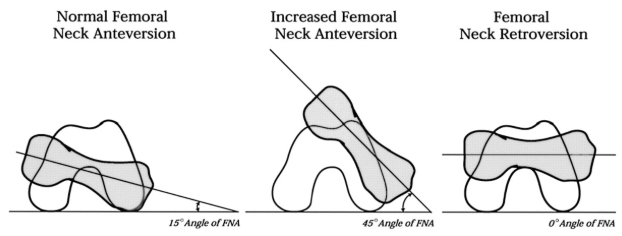
Patient Education: Femoral Version Abnormalities
Education
Femoral Version Abnormalities
The alignment of the femur (thigh bone) plays an important role in how the hip functions. Femoral version refers to the rotational alignment of the femur — specifically, the angle between the neck of the femur and the rest of the bone.
When the femoral version is outside the normal range, it can lead to issues with hip stability, range of motion, and joint loading. These abnormalities may contribute to hip pain, impingement, instability, or early joint degeneration.
What is Femoral Version?
Femoral version describes the rotation of the femur relative to the knee and hip. There are two main types of abnormalities:
Femoral Anteversion: Increased forward rotation of the femoral neck relative to the shaft of the bone.
Femoral Retroversion: Decreased or reversed rotation, where the femoral neck points more backward.
Normal femoral version is typically around 10–20 degrees of anteversion. Variations outside this range can affect hip mechanics and lead to symptoms.
How Does Femoral Version Affect Hip Function?
Proper femoral alignment allows the hip joint to move smoothly and efficiently. When femoral version is abnormal, it can cause:
Decreased range of motion: Especially in rotation.
Abnormal joint loading: Leading to cartilage and labral stress.
Hip instability or impingement: Depending on whether the femur is over-rotated or under-rotated.
Changes in gait mechanics: Causing compensatory movements or discomfort in the hip, knee, or lower back.
Patients with version abnormalities often experience hip pain, clicking, catching, or a feeling of stiffness.
Symptoms of Femoral Version Abnormalities
Symptoms can vary but commonly include:
Hip or groin pain, especially with activity
Limited hip rotation (either internal or external, depending on the abnormality)
Mechanical symptoms like catching or locking
Difficulty with squatting, pivoting, or certain athletic movements
In some cases, pain in the knee or back due to compensatory movement patterns
Diagnosis
Diagnosing femoral version abnormalities involves:
Physical examination: Assessment of hip range of motion and functional testing.
Imaging studies: Advanced imaging such as CT scan or MRI can accurately measure femoral version and help guide treatment planning.
Version is often considered along with other factors, like acetabular version and hip coverage, to fully understand joint mechanics.
Treatment Options
Treatment depends on the severity of the abnormality and the patient’s symptoms:
Non-Surgical Management:
Activity modification
Physical therapy to strengthen surrounding muscles and improve mechanics
Pain management strategies
Surgical Management:
In cases of significant symptoms and version abnormality, a femoral derotational osteotomy may be considered. This procedure involves cutting the femur and rotating it to a more normal alignment, then fixing it with a plate and screws.
This can restore normal joint mechanics, relieve pain, and prevent further joint damage.
The decision to pursue surgery depends on symptoms, degree of version abnormality, and overall hip health.
Recovery and Outlook
Non-Surgical Treatment:
Focuses on symptom management and maintaining function. Some patients can manage well without surgery, especially with physical therapy.Surgical Recovery:
After femoral osteotomy, recovery involves:Limited weight-bearing for the first several weeks
Physical therapy to restore motion and strength
Gradual return to activities over several months
Surgical correction can significantly improve pain and function in appropriately selected patients.
Conclusion
Femoral version abnormalities are an important but often overlooked cause of hip pain and dysfunction. Accurate diagnosis and a thoughtful treatment plan are essential to improve symptoms and protect the hip joint over time.
If you are experiencing hip pain or limited motion and are concerned about hip alignment, contact our office for a full evaluation and personalized treatment plan.

